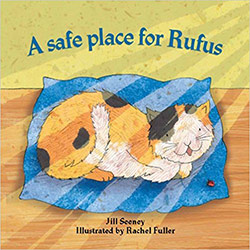The story is told in a simple way that is suitable for young children. Rufus the cat clearly represents a child who has had a difficult past with a previous family.
Rufus loves curling up on his favourite blue cushion and dreaming of his favourite things. But he hasn’t always been so contented. When he was a kitten, he lived with a family who weren’t always kind (he was shouted at and he didn’t have enough food to eat). Those bad memories followed him into his new home (the memories are shown as wispy ghost-like cat ‘spirits’ in the illustrations) and Rufus found them very difficult to shake off. Those memories made him feel angry (he roars at the children in his new home) and he refused to eat anything but pilchards (the food he used to dream about when he was underfed). The turning point of the story comes when Rufus realises that being angry and fighting is getting him nowhere (he gets tangled in some washing and can’t get free, so flops down and keeps still). He suddenly notices a beautiful blue cushion bathed in beams of sunlight (which has been left there by the family, hoping Rufus will discover it). Shaking himself, he settles down in his lovely new ‘safe place’. The bad memories disappear through the window and leave him at peace at last. Over time, Rufus settles in with the family and allows himself to be loved and cared for by them. He begins to eat different foods. Although he is still a little anxious (and likes to stay close to home), he knows that he always has a safe place to return to if he’s feeling troubled.
The gentle story is engaging enough to hold a child’s attention. Rufus is a very appealing character, beautifully depicted by illustrator Rachel Fuller.
 This book would be a good choice for children who have experienced trauma in their lives which has left them feeling anxious in new situations. Also relevant for children who are struggling with transitions such as moving house, changing school or moving from one family to another.
This book would be a good choice for children who have experienced trauma in their lives which has left them feeling anxious in new situations. Also relevant for children who are struggling with transitions such as moving house, changing school or moving from one family to another.
